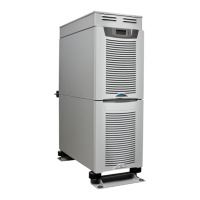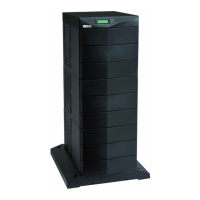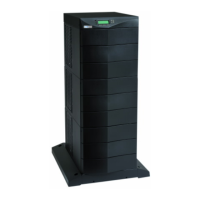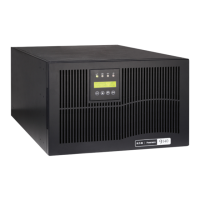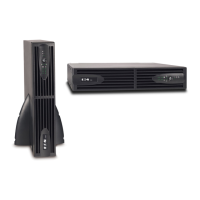Do you have a question about the Eaton Powerware 9130 and is the answer not in the manual?
General safety instructions for UPS installation and maintenance.
Procedures for checking equipment for shipping damage.
Steps to safely unpack the UPS cabinet and accessories.
Verifying all included accessory items for the UPS and EBM.
Hardware and steps for installing the UPS in a standard rack.
Connecting internal batteries and optional EBMs for rackmount UPS.
Procedures for placing the tower UPS in its final location.
Connecting internal batteries and optional EBMs for tower UPS.
Steps for powering on and initializing the UPS after installation.
Overview of the UPS front panel LCD and buttons for operation.
Instructions for selecting the display language on the UPS.
How to navigate and view information on the UPS LCD screen.
Customizing UPS parameters like language, alarms, and output voltage.
Explanation of Normal, Battery, Bypass, and Standby modes.
Procedures for starting up and shutting down the UPS unit.
How to manually switch the UPS between Normal and Bypass modes.
Accessing UPS event history through the display or serial port.
Configuring energy-saving or high-efficiency modes for UPS operation.
Adjusting parameters for bypass operation, like voltage limits.
Managing UPS outlets for controlled shutdown and startup.
Setting up the UPS for installed EBMs and battery tests.
Information on automatic battery testing for UPS health.
Setting UPS behavior for automatic restart after utility power restoration.
Steps to install communication cards and cables.
Overview of USB, RS-232, and connectivity card options.
Connecting a computer to the UPS via serial or USB ports.
Details on available cards like Web/SNMP and Relay Interface.
Using the REPO feature to shut down the UPS remotely.
Understanding and configuring relay outputs for UPS status.
Configuring inputs for external signals like remote shutdown or alarms.
Information on configuring modem features for remote access.
Using software for UPS monitoring and management.
General guidelines for maintaining the UPS and its batteries.
Recommended procedures for storing the UPS for extended periods.
Identifying signs that indicate the need for battery replacement.
Step-by-step guide for replacing batteries in rackmount models.
Step-by-step guide for replacing batteries in tower models.
Guide for replacing Extended Battery Modules in rackmount configurations.
Guide for replacing Extended Battery Modules in tower configurations.
Procedures for testing new UPS batteries after installation.
Information on proper disposal and recycling of UPS components.
How to keep the UPS firmware up-to-date for optimal performance.
Details on communication options, model lists, weights, and dimensions.
Diagrams showing rear panel configurations for different UPS models.
Common UPS alarms, their causes, and recommended actions.
How to temporarily silence UPS alarms from the front panel.
Contact information and procedures for obtaining technical assistance.
Details of the standard two-year warranty terms and conditions.
Information on the extended ten-year pro-rated warranty.
Details on the guarantee for equipment protection against power surges.
General safety instructions for UPS installation and maintenance.
Procedures for checking equipment for shipping damage.
Steps to safely unpack the UPS cabinet and accessories.
Verifying all included accessory items for the UPS and EBM.
Hardware and steps for installing the UPS in a standard rack.
Connecting internal batteries and optional EBMs for rackmount UPS.
Procedures for placing the tower UPS in its final location.
Connecting internal batteries and optional EBMs for tower UPS.
Steps for powering on and initializing the UPS after installation.
Overview of the UPS front panel LCD and buttons for operation.
Instructions for selecting the display language on the UPS.
How to navigate and view information on the UPS LCD screen.
Customizing UPS parameters like language, alarms, and output voltage.
Explanation of Normal, Battery, Bypass, and Standby modes.
Procedures for starting up and shutting down the UPS unit.
How to manually switch the UPS between Normal and Bypass modes.
Accessing UPS event history through the display or serial port.
Configuring energy-saving or high-efficiency modes for UPS operation.
Adjusting parameters for bypass operation, like voltage limits.
Managing UPS outlets for controlled shutdown and startup.
Setting up the UPS for installed EBMs and battery tests.
Information on automatic battery testing for UPS health.
Setting UPS behavior for automatic restart after utility power restoration.
Steps to install communication cards and cables.
Overview of USB, RS-232, and connectivity card options.
Connecting a computer to the UPS via serial or USB ports.
Details on available cards like Web/SNMP and Relay Interface.
Using the REPO feature to shut down the UPS remotely.
Understanding and configuring relay outputs for UPS status.
Configuring inputs for external signals like remote shutdown or alarms.
Information on configuring modem features for remote access.
Using software for UPS monitoring and management.
General guidelines for maintaining the UPS and its batteries.
Recommended procedures for storing the UPS for extended periods.
Identifying signs that indicate the need for battery replacement.
Step-by-step guide for replacing batteries in rackmount models.
Step-by-step guide for replacing batteries in tower models.
Guide for replacing Extended Battery Modules in rackmount configurations.
Guide for replacing Extended Battery Modules in tower configurations.
Procedures for testing new UPS batteries after installation.
Information on proper disposal and recycling of UPS components.
How to keep the UPS firmware up-to-date for optimal performance.
Details on communication options, model lists, weights, and dimensions.
Diagrams showing rear panel configurations for different UPS models.
Common UPS alarms, their causes, and recommended actions.
How to temporarily silence UPS alarms from the front panel.
Contact information and procedures for obtaining technical assistance.
Details of the standard two-year warranty terms and conditions.
Information on the extended ten-year pro-rated warranty.
Details on the guarantee for equipment protection against power surges.
| Input Frequency | 50/60 Hz |
|---|---|
| Power Factor | 0.9 |
| Transfer Time | 0 ms |
| Efficiency | Up to 95% |
| Humidity | 0-95% non-condensing |
| Output Frequency | 50/60 Hz |
| Battery Type | Sealed Lead Acid |
| Runtime | Varies by load |
| Dimensions (HxWxD) | Varies by model |
| Weight | Varies by model |
| Operating Temperature | 0 to 40°C |
| Storage Temperature | -15 to 45°C |
| Communication Interface | RS-232, USB |
| Safety Approvals | UL, cUL, CE |
| Topology | Double-conversion online |
| Audible Noise | <45dB at 1m |


